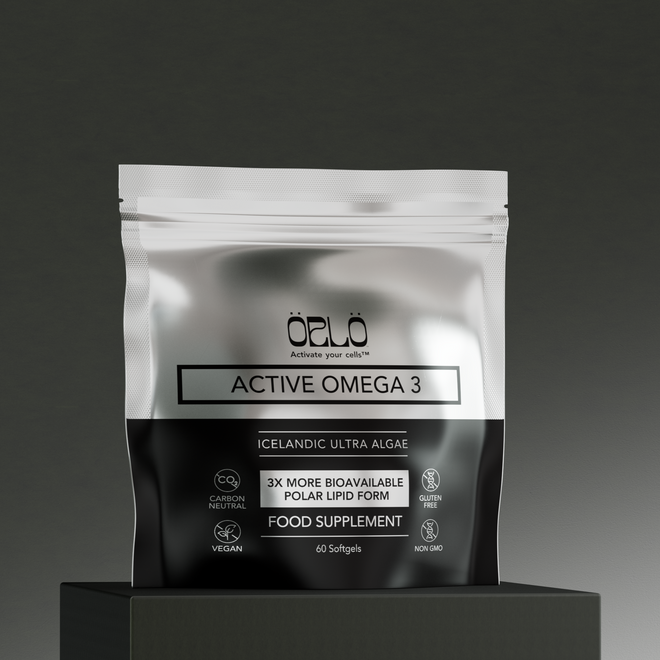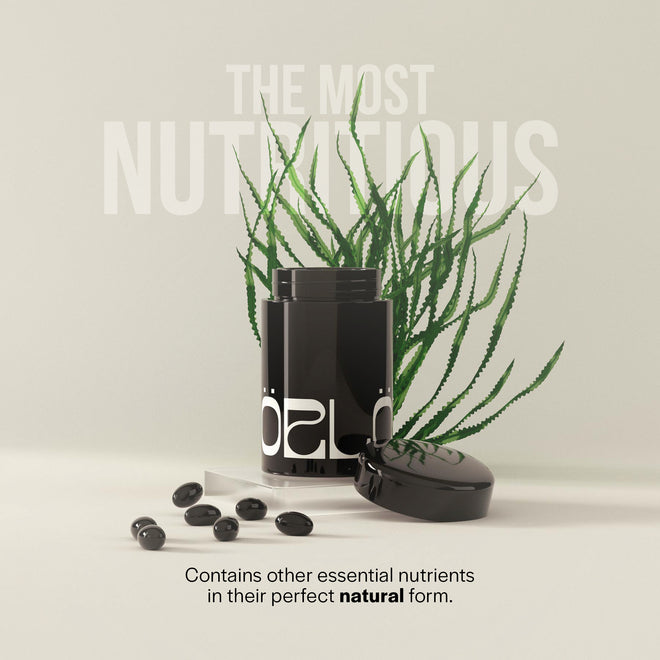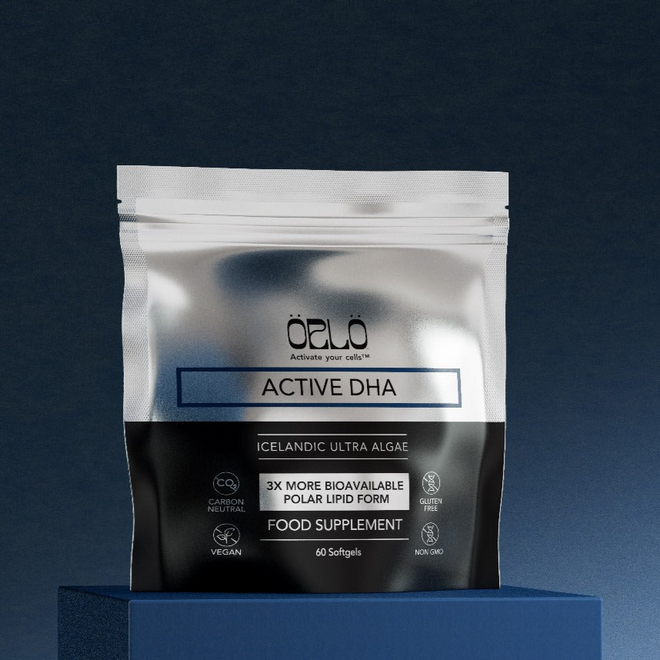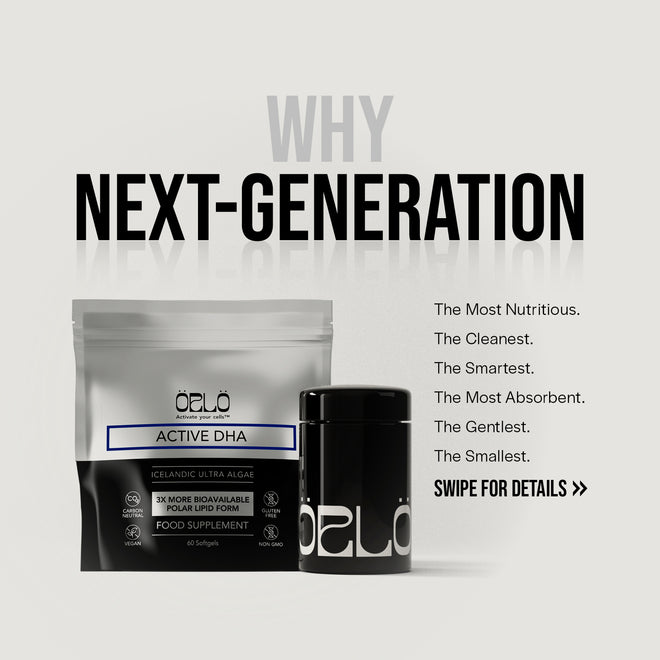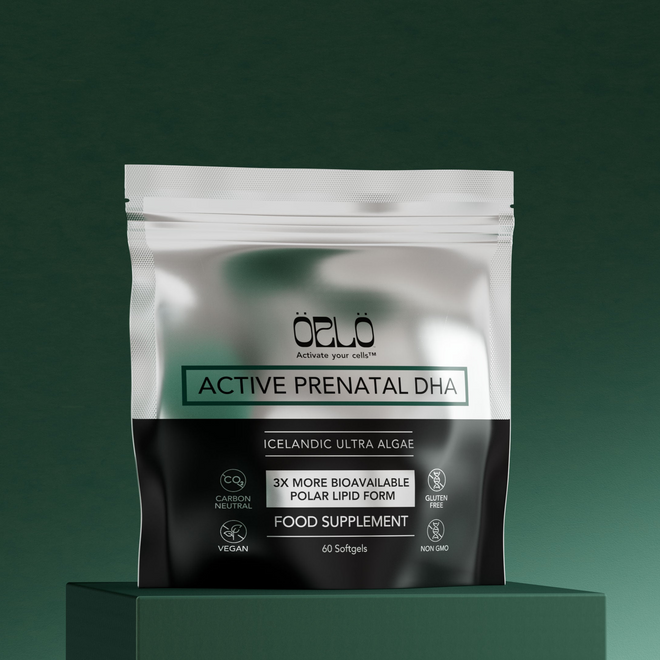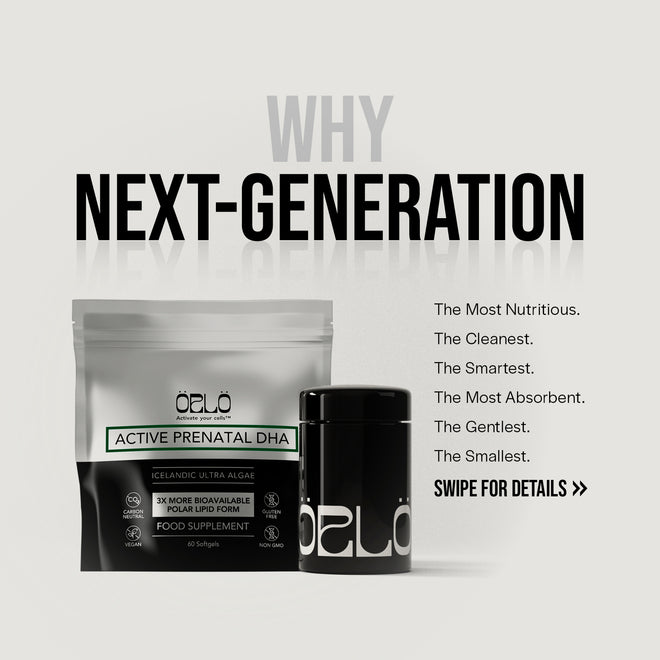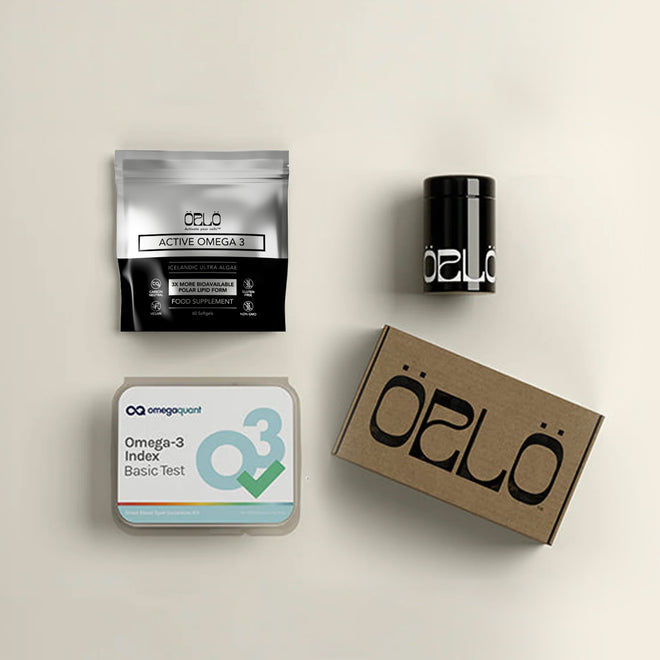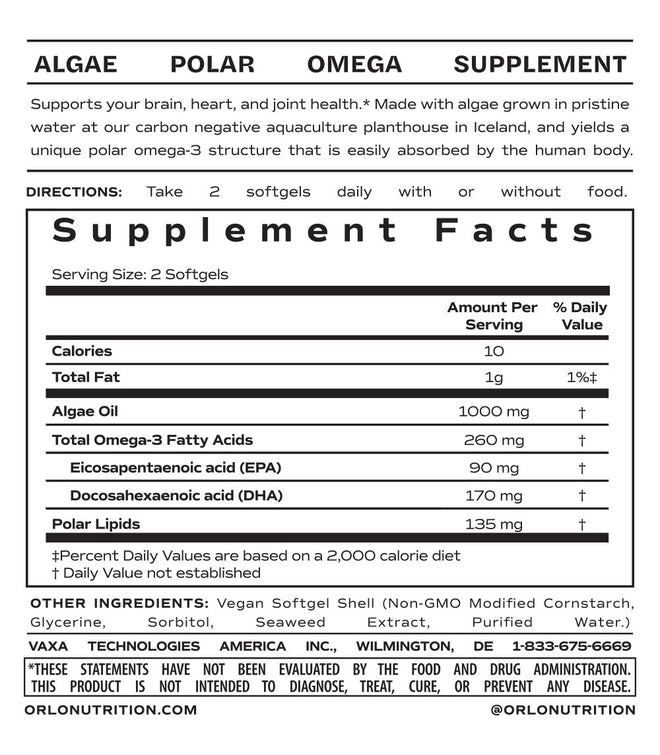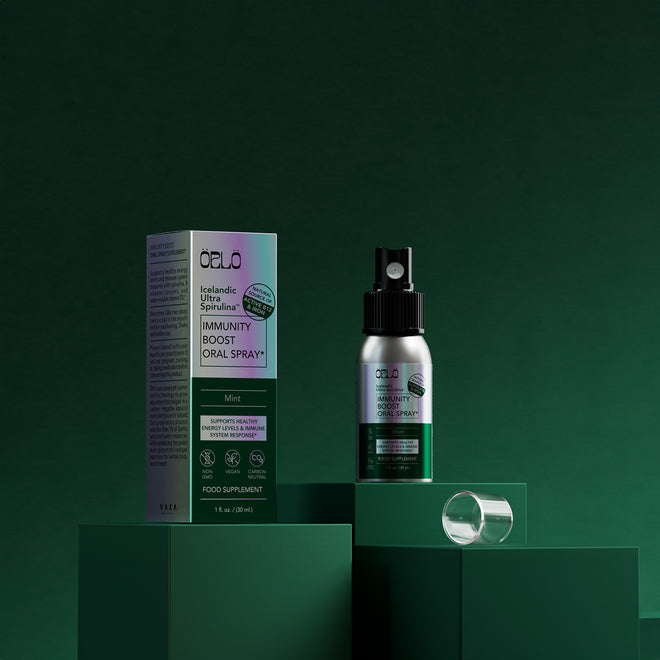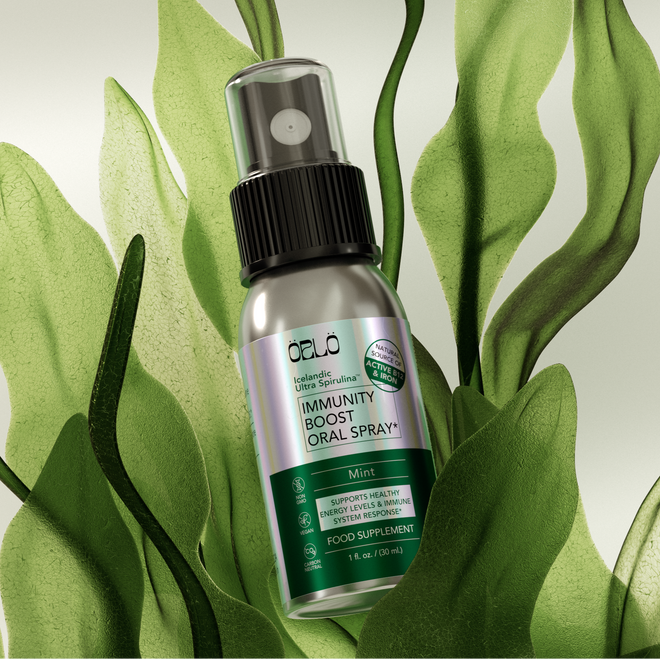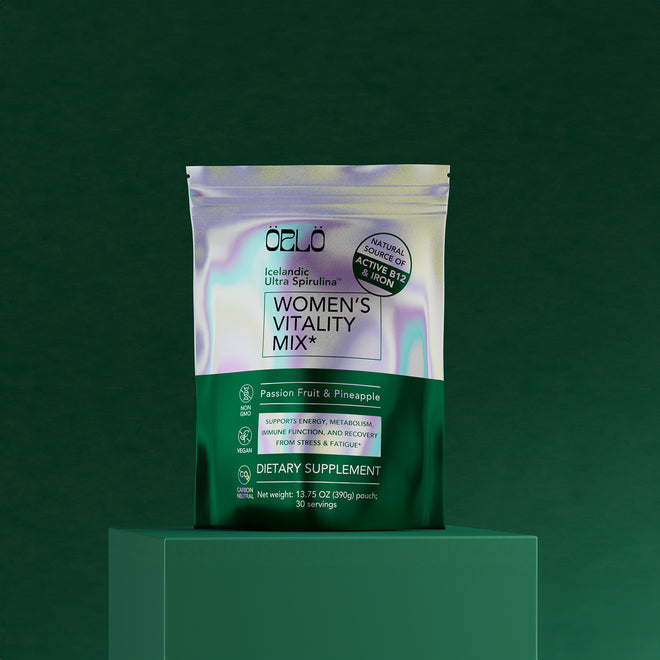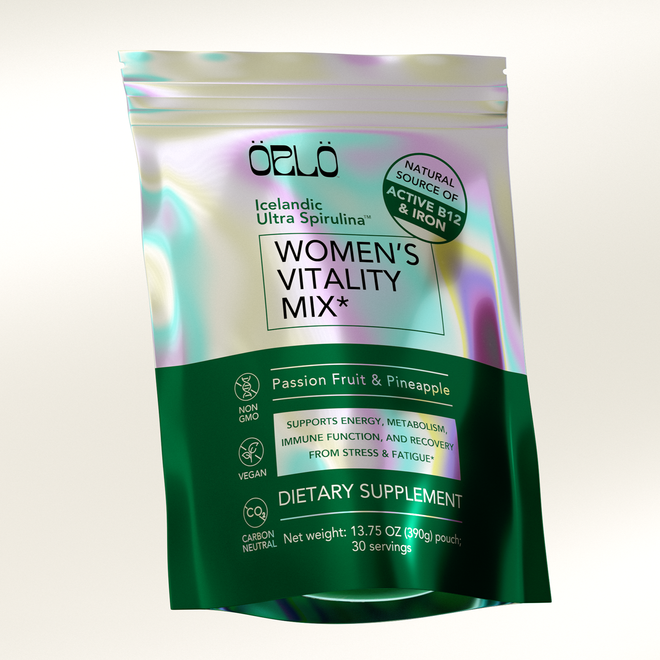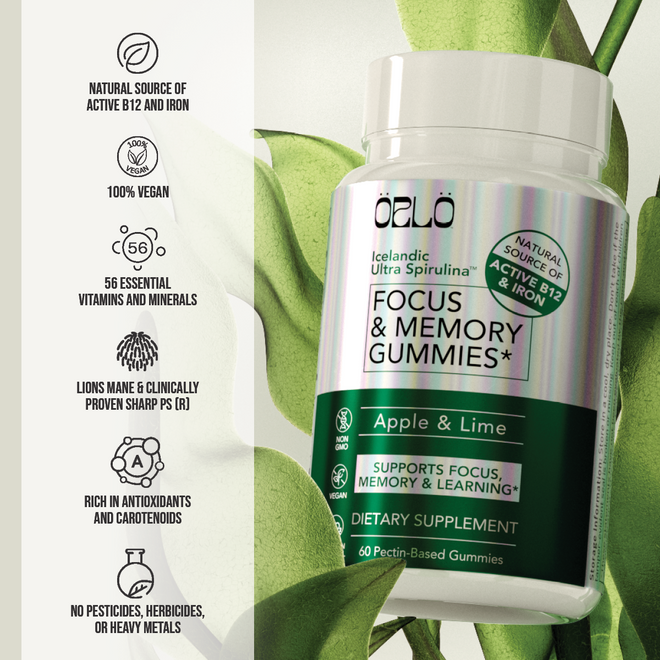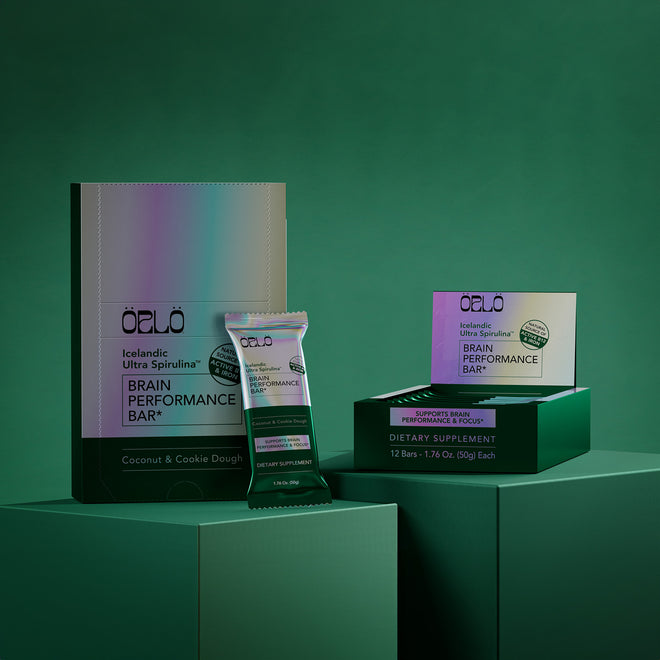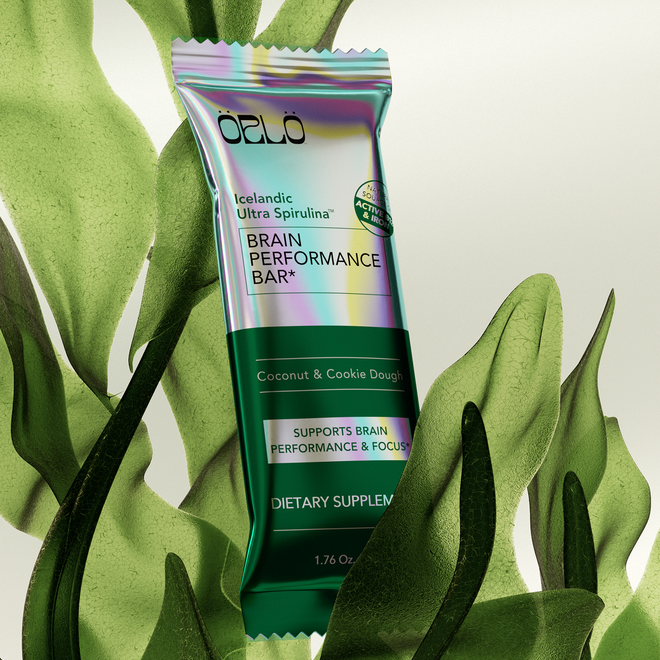25% Off - use code: HOLIDAYS
How Bioactive Algae Can Help People and Planet Thrive with Professor Isaac Berzin | Forever Young Radio Show's 500th Episode
Listen to the Episode Here:
In this episode of "Forever Young" the host, Kelly Cappasola, celebrates the 500th episode with special guest Corinna Bellizzi and featured guest Professor Isaac Berzin. The focus of the episode is on the benefits of algae, specifically in the context of bioavailable nutrition and sustainability.
Key highlights from the episode include:
-
Introduction of Algae as a Nutritive Source: Isaac Berzin, a notable figure for his work in sustainability and with a background in chemical engineering and biotechnology, discusses his fascination with algae. He explains how algae play a crucial role in producing oxygen, forming the basis of the food chain in oceans, and acting as a primary source of omega-3 fatty acids.
-
Benefits of Algae over Traditional Omega-3 Sources: Berzin shares insights into the unique advantages of algae as a source of omega-3s, emphasizing its efficiency in CO2 fixation and its potential to sustain life on Earth. He contrasts algae's comprehensive nutritional profile with traditional crops and highlights its role in producing essential amino acids and fatty acids without the agricultural waste associated with staple crops.
-
Innovations in Algae Cultivation and Production: The conversation delves into the technological advancements in algae cultivation, particularly the integration of algae production facilities with geothermal power plants in Iceland. This integration allows for optimal growth conditions, such as controlled light and temperature, which significantly enhance the production of valuable compounds like omega-3 fatty acids.
-
Carbon Neutrality and Sustainability: Berzin explains how the cultivation process of microalgae in Iceland, leveraging geothermal energy and carbon capture, achieves carbon negativity, a rare feat in agricultural activities. This sustainable approach not only addresses carbon footprint concerns but also reduces land and water usage compared to traditional cultivation methods.
-
Future Directions and Applications: Looking ahead, the discussion touches on the potential for algae-based products in various industries, including nutrition, where algae's high protein content and essential nutrients can support healthier, more sustainable food options. The episode also hints at upcoming products and collaborations aimed at incorporating algae into everyday diets, thereby promoting both environmental sustainability and nutritional benefits.
The episode underscores the importance of algae as a key player in future sustainable food systems and nutritional supplements, emphasizing its role in promoting health and environmental sustainability.
Original episode republished with the permission of Forever Young Radio Show and their host, Kelly Cappasola.
Complete Episode Transcript:
Kelly Cappasola: Hello everyone, so glad you could join us today right here on Forever Young. If it's the first time you've caught our show, whether it be on the traditional radio dial, Sirius XM, or any of our wonderful podcast platforms, welcome to the show and thank you so much for finding us. We appreciate our listeners who tune in each and every week and have for well over two decades.
Very important program. We are here each and every week to inform and educate you all about good quality science-based information, trends that are going on, ones you should incorporate, maybe ones you should avoid, and again, learning more about your own health journey and different things you can work in.
We have a very special show. This is our 500th episode on the podcast. I'm really excited about that and been able to have such a great opportunity to educate you guys and to be able to share this wonderful information, not only with the wonderful sponsors and guests that we bring on this program, but even the wonderful co hosts that have been joining me.
For goodness, well over two decades today, I have a very special co host. That is Corinna Bellizzi. Again, just a wonderful powerhouse has multiple platforms where she communicates with consumers on her podcast, uh, works for a wonderful company, ÖRLÖ Nutrition. She's also educated us on the benefits of polar lipids and algae.
And Corinna, I'm so grateful that you could be with me today to introduce a phenomenal first time guest. Thanks to you. So welcome to the show.
Corinna Bellizzi: Wow. 500 episodes, Kelly. I think we deserve a round of applause just for you right now. Now, I just, I just love your show. The, everything that you've been doing with it for the entire history is just incredible.
And I'm so honored to be here to introduce the amazing founder and CTO of VAXA technologies. And that's Professor Isaac Berzin. He was named one of the 100 most. influential people by Time Magazine for his work in sustainability and climate change. Isaac is an affiliate scientist at MIT, where he worked on a NASA sponsored project, which developed bioreactors for the International Space Station.
So truly space age technologies. His innovative work in green fuel technologies has won numerous awards, including the Frost and Sullivan Award, the Platz Global Energy Award, and American Society of Competitiveness. He is coming off the heels of an event in Davos that is all about sustainability. So I'm sure we'll hear a little bit about that today.
He also holds a PhD. And chemical engineering and biotechnology from Ben Gurion University of the Negev, Israel. So a fantastic show planned for us all today. And I'm just so thrilled that we get to have this conversation.
Kelly Cappasola: Absolutely. Again, without further ado, Isaac, thank you so much for joining us on the program today.
Isaac Berzin: Well, I'm happy to be here and I already feel the energies, oh my God.
Kelly Cappasola: There's a lot. I blame it on ÖRLÖ Nutrition. It gives me natural energy. I don't drink coffee. So here you have it. But again, your story is just fascinating. You started working with algae from a greener energy source first and possibly even in its role to sequester carbon in space.
But what first drew you to algae for its nutritive content those years ago?
Isaac Berzin: Well, Yeah, it's actually a funny story. So I fell in love with algae again during my years at MIT as a young scientist. Um, only to realize the important role algae play in creating life on this planet and the key role they should play in sustaining life on this planet.
Uh, algaes are, uh, you can think about them as, uh, single cellular plants. They're absolutely cute. They come in many shapes and forms and colors. Some of them have little mustache. It's called a flagella. They swim around and, um, and like all other plants. You know, they think that CO2 is a gourmet food. They fix it using photosynthesis to do into an organic matter and then further metabolize it to all of the things that we call essential amino acids and essential fatty acids, etc.
And but you know, unlike staple crops, for example, which are mostly agricultural waste in microalgae, there's no waste because there's no stems. There's no leaves. There's no roots, right? They grow by cell division. So there's no waste. It's 100 percent basket of nutrition. So it fascinated me. It really, it really did.
And, and then, you know, my kid used to ask me, Dad, what's the connection between algae and life? It's like remote from life. Is it really? So I'll tell you top secret, three fun facts. Ready? Yes. One is most of the oxygen that we breathe right now is not coming from the rain forests. It's actually coming from, uh, microalgae in the oceans.
The second fun fact is Uh, what we call petroleum. It used to be something, right? Organic material. It was not dinosaurs, it was mostly microalgae and omega threes do not come from the fish. I mean, we get it from the fish, but that's a secondhand Omega-3. They are actually synthesized by microalgae, and then the fish just accumulate them up the food chain.
So it is connected to life. It's the key of life. Nevertheless, it doesn't have enough PR, right? So thank God there are amazing shows like this. We can promote algae and put them in the right place in the, in of order. So yeah, I was looking for a ways to cultivate microalgae in a sustainable way in a meaningful market.
And again, the first market I was looking at was energy. And when we were cultivating these microalgaes, there was something in the oil that bothered it. Or disturbed it from being a great fit for, for fuel. Because when you're looking for fuel, you want to see 16 chains, okay? Fat chains. And this was like something in the middle.
This something in the middle was omega 3. So, uh, once we realized that we had very special omega 3, we also realized that the form is very unique. You know, if you look at the second hand omega 3, okay, fish or krill, they come in different forms. One of them, triglycerides, mostly from fish. And another form is phospholipids, which comes from mostly krill.
But these guys have something unique, which was called glycolipids. Polar molecule with a, with a sugar head that makes it polar. And, uh, there was even no analytical method to measure it. So I have to develop the analytical method to measure it. And then we thought, is it good? Is it bad? It's very unusual.
And then we started looking into what it actually does for you. And, um, and that's kind of the history of what got us here, but I'll tell you what I learned over 20 years of, uh, cultivating algae all over the world, really, literally all over the world. It's a lot like marriage because you need to keep algae happy all day, every day.
And this is really, really hard providing them the optimal growth conditions. I'll give you an example. Light quantity, light quality, light and dark cycles, pH, temperature. It's a basket of conditions that if you maintain them and, and provide them, you know, happy wife, happy life, same with algae. So what they do for you, they overproduce compounds of interest.
For example, omega 3. Now, why is that important? Okay. Because if you have a very high concentration in the, in the core algae, you can do very little processing steps to get into a marketable product. Okay. Because unfortunately that specific algae we grow, it's called nanocoropsis. It's beautiful and amazing, but it's not digestible.
So if you just eat the algae, you will not get the benefits of, of the omega 3. It will go out just the way it came in. Um, so you have to extract the oil and extracting the oil needs to be done gently to maintain this polar structure.
Kelly Cappasola: and when we come back from the break Isaac I'd love to be able to explore that a little bit more listeners You can learn more on Forever Young Radio.
<< Ad Break>> 8:55
Welcome back listeners again We are getting a special treat today being joined by isaac. Just a wonderful Individual wonderful educator and again professor isaac burson is joining us today Uh for our 500th episode, but i'm also being joined by my co host Corinna Bellizzi, the host of Nutrition Without Compromise.
Boy, just in the intro, I've already learned like 10 things that I didn't know about. And I know that Isaac is a wonderful husband because he said, happy wife, happy life. What do you say, Corinna?
Corinna Bellizzi: Well, I can echo that. But at the same time, I just think that they're learning why algae is so freaking cool. And one of the keys that I like to remind people of is just that this is the world's first plant.
I mean, the fact that life started there. Is really, I think what makes it so fascinating at this rudimentary level and Isaac just gave us a very, I would say, descriptive explanation of why that's the case, but it's just an exciting little greener energy source for all of us. I’m thrilled to have Isaac here and I personally want to dig in a little bit more.
Into how we grow these algae for their omega-3 content. I think you've gone into that a bit here, but polar lipids may still really confuse people. How is this as unique as it is? And why is this so new? Like why isn't this readily available everywhere else?
Isaac Berzin: Yeah. So it's a great question, Corinna. So, you know, sometimes the middleman creates value.
I'll give an example. You want to drink your milk with coffee. So you want to put coffee, you want to put milk. You don't want to put the cow in your coffee. Right. So the cow created value in a way you don't do. Okay. But in our case, since we get it from the second hand, I'm not only talking about the potential contamination that you have in Marine life.
Which mirrors the situation of the oceans. Okay. I'm just talking about the molecular structure. We do not get an upgrade. Actually, we get a downgrade, and I'll explain why. Think about your stomach as a bucket, and it's full of liquids. And then, if you put oil and water, everybody have tried it, I'm sure, you can see easily that the oil is creating a layer on top.
So, if absorption from the stomach into the blood system happens, on the sides of this bucket, right? These are the sides of your stomach. There's only like a ring around this layer that's actively working for mass transfer. Nevertheless, if you mix polar lipids with oil, the polar structure creates a, like a, like an emulsion.
So it's spread all over you. There's no two layers. It's, it's all over the place. And then all of the sides of your stomach are actively playing a role in mass transfer, in getting those omega 3 molecules into your bloodstream. That's only the first barrier. You need to cross the barrier from the stomach to the blood.
Then there's another barrier to cross from the blood to the organs. And then molecular structure plays a role. It's not a diffusion process. They have, you know, cells, cell walls have gates. And, uh, these are just keys to enter the cells. So it's a very efficient way on, uh, I would say biochemical level and also on the kind of practical physical chemical level.
Okay. So in the end, why am I saying such a long story in the end? It doesn't matter what you swallow. What matter is what what's making impact on your body. What's what's going into your bloodstream and from the bloodstream to your tissues and which tissues, et cetera. And there are phenomenal works that are looking into the brain, blood barrier, and there's a whole world about, you know, digestion and nutrition are complicated worlds.
They're non linear. So sometimes getting close to the original first hand prime producer basically brings with it all the nutritional levels that you lose if you take it down the food chain. Okay? So in this case, I think the art is to respect nature. to respect the prime producer of these key molecules and also to tailor technology around them.
A, to keep them happy and productive and enhance the metabolic pathways that create those molecules. And then when you extract it to be also gentle and respectful and minimize the impact. You want to be as close as possible to a whole food rather than a processed food. And that's a big difference. You think about quality and omega three, the coming from fish many times, it's a concentrated form, right?
Why? Because a lot of the other things you really don't want to swallow. So you want to concentrate it from omega three in our case, because it's coming from algae oil. It's a, it's a basket of nutrition. You think only the omega three is the, is the. There's a lot of wonderful things out there. So actually, if you get it into a marketable concentration, that's it.
You don't have to separate any garbage or any toxic things because there aren't any. So there are a lot of advantages of this, you know, going to the source.
Kelly Cappasola: Yeah, but a lot of companies are not going to the source. And I think that's where the big gap has been created out there. And again, realizing all of the things that you're looking at and not just trying to bring a product to market, I mean, is phenomenal.
I think if you wouldn't mind, Isaac, could you just explain to our listeners what makes ÖRLÖ growing technology so different than maybe other things and products that are out there?
Isaac Berzin: It's a evolutionary step. Think about it. When you take, uh, when you take, uh, algae from fish, what are you? A hunter gatherer, right?
You just grab the fish and squeeze the oil out of it. Great. What we're doing is we're taking this microalgae cultivation, even beyond agriculture, it's technology. Okay. And in order to provide all these wonderful growth condition, you have to control them. So, you know, if you're growing algae with sunlight, you do not control the sunlight.
You do not control the composition of light. You cannot control day and night, right? So. We made a brave step into integrating an algae production facility with a geothermal power plant. It was never done before, and the rationale was as follows. When you, when you want to grow algae with optimal light conditions, you can use LED technology, which in the last 10 years made huge steps forward.
So you want to tailor the light composition, the light wavelengths, the light colors, to what the algae prefers, and also the intensity. And then, if you grow algae in kind of a vessel, when the algae are close to the light source, they see a lot of light. But algae, if you look at it, it's like green water, they shed the light.
So in the middle of this bucket, okay, you have low light, you have darkness. So if you're an algae and this bucket is mixed, what do you feel? You feel light when you're close to the edge. And then you go, you feel dark. So you feel light and dark cycles. So that's another dimension of light. It's not only the composition, not only the intensity, it's the light and dark cycle, it's called photo modulation.
And then you need to keep the algae happy from thermal perspective. So you need access to cooling water and. And from that perspective, this geothermal power plant was a one stop shop. Why? Because you have clean and cost effective energy, geothermal energy, okay, 24 7. You have this, this specific power plant.
It's about 20 minutes away from Reykjavik. It's one of the largest power plants in the world. They basically, in Iceland, they, what they do, they drill, you know, a few kilometers down the ground and they get steam coming out of them. We have to burn fuels to create steam to make electricity. There, steam is coming from the ground, because the ground is very close to the lava layers, and then they operate as turbines.
But once the, once the steam is cooled a little bit, it's still very hot. What do they do with it? They heat water. So if you take a shower in Reykjavik, there's a high likelihood this hot water came from that power plant. So it's, it's the open, open public pools and, and, and they even have a private ocean beach where they pour this hot water into so you can swim in the ocean.
And so, so this power plant has a huge pipe of cold water, six centigrade coming in and the same pipes pipe of hot water about 87 degrees centigrade coming out. So we're integrated into this. Waste streams of cold water and hot water so I can keep any algae happy in optimal temperature and I do not waste any water because it's a, it's a flow through.
Okay. And, and, and another thing is when, when they get the steam from the ground, a small portion of it is CO2. So they, they concentrate it and then they Before they met us, they were just injecting it back into the ground or releasing it to the atmosphere. And we told them, why would you ever do this?
It's gourmet food. Come on. So, so, so it's really a one stop shop to, to, to keep algae happy, but there was a technology gap. The reason it was not done before, there was no technology that enabled this integration. And without this integration, with all due respect, you're out of the range of, of, um, cost effective, uh, production.
I mean, with all due respect, primary, great, but, you know, you cannot punish your customers. They're not going to pay 100 for a pill, right? No. On a daily basis. So, so there's a, it should be all within reason. And yeah, so this was the kind of the key that we had to unlock.
Kelly Cappasola: Yeah. And I've been able to see some of those photos.
I mean, um, you've been able to share it with me, Corinna. Uh, when I saw you at supply side, you showed me a number of these pictures, and it was just phenomenal. And when we come back from the break, I know we have some additional questions, uh, that you had for Isaac, but I want our listeners to go and check out this website and learn a little bit more, not only about the technology, but to see some of the algae, which is.
Goodness. It's so bright. It's so green. Uh, you can do that at ÖRLÖ nutrition. Again, that's O R L O nutrition. com there. You can not only read about everything I shared with you, make sure you keep that page because there's a lot of phenomenal articles that are coming out of there. Really great, uh, information on how we can apply algae into our day to day life, um, and utilize it in a way that we're actually feeling it and knowing that we're getting in proper levels.
If you'd like to learn more, say you're working out and you can't remember or low nutrition. com. We would put this all on our weekly highlight page at forever young radio. com. So you can go and follow up for the next two weeks. Stick with us when we come back from the break with our special friends at ÖRLÖ nutrition.
Corinna Bellizzi: Thank you again for joining us for Forever Young Radio Show. I am a co-host today, Corinna Bellizzi, joined by Isaac Berzin, professor and amazing PhD in the space of algae and technology. We are talking now about carbon neutrality as it relates to ÖRLÖ Nutrition's growing of algae for human consumption and its amazing abilities overall.
Now, many brands, generally speaking, They guess what they talk about carbon neutrality. They seek to meet what these global goals by the UN have been for running more sustainable business practices. Those so called sustainable development goals. What makes ÖRLÖ truly carbon neutral and even potentially carbon negative.
Isaac Berzin: Yeah. So, uh, it's a great question, Corinna, and you know, I'm an engineer, so I don't understand word, I understand numbers. Okay, so what we did is we teamed with, uh, Cambridge University, uh, DTI, the Danish Technological Institute, and MATIS is the National Lab of Iceland. They conducted something called life cycle analysis, which actually measures your carbon footprint, and they measure everything.
The energy that went into building the building, the energy went into fertilizer, the energy that you're using to keep the algae happy, everything, okay? They concluded that the cultivation of microalgae in Iceland, the way we do it in integration with a geothermal power plant, is carbon negative. That's huge.
I don't know any other agricultural activity that's carbon negative. Where does coming emissions come from? Yes, algae eat CO2. And yes, roughly for one ton of algae, they, they ate two tons of CO2, roughly 1. 8 to be precise. Okay. That's all true, but in order to mix them, to light lit them, to harvest them, you, you invested energy.
This energy came with a carbon toll. Also, half of their body is carbon, great from the CO2, wonderful. But what about the other half? It's fertilizers. So fertilizers are coming with a tremendous carbon footprint. So if you look at it all in all, I don't know of any, any other agricultural activity. That's carbon neutral.
And the key was twofold. Number one, all the thermal management to keep algae happy thermally is done with waste streams. So we don't have chillers. We don't have heaters. Okay. The second thing is all the energy we use is very, very clean. Geothermal energy is one of the lowest energies from the point of view of carbon footprint.
Okay? And we even get the, the power directly from the, the source directly from the power plants. So we don't even have, uh, grid losses on, on that. Mm-Hmm. . And the third thing is we use mind open picked fertilizers. So nothing that was made, uh, synthetically from natural gas, for example. Okay. So all together, it brought us to this amazing platform of, of carbon and actually negativity.
We don't say carbon negative because people think it's a negative thing. Carbon negative is a positive thing, but you know, we measure sustainability in many ways. This is one of them. Carbon, carbon footprint is a major one. I agree totally. Um, but think about the land footprint. This is vertical. Farming of microalgae.
We have a lot of surface of light and algae, which you need to cultivate algae, but it's a folded together vertically. Okay. If I had to, if I had to unfold it and create like an open pond, this would be like maybe one of the largest open ponds in the world, but it's not it's for like origami. And it's so, so the footprint is very, is very small.
And actually it's lava. It's lava feed. Nothing grows there anyway. Okay, so we do not compete with food production online. What about water? When you look at an open pond, for example, and that's the way most algae are cultivated, you don't realize that it's a horrific camel. It drinks a lot of water. Why?
Because water evaporation, mainly in warm places, is about two meters of water per year. So if you have a pond, two meters of water after one year, it's dry completely. People say, okay, so we use brackish water. Yes, very, very true. I can use brackish water, but what evaporates is H2O. It's water. The salt stays.
So if I do not compensate with fresh water, the salinity is going to go through the roof. The algae are going to die. So even that, you know, even if you use brackish water, you have to compensate for evaporation with fresh water. And fresh water is a finite resource. So, so I think it's a breakthrough. So we, we, we use less, less than 1% of the land and one less than 1% of the water compared to traditional way to, to of cultivate macro.
And because we are actually sitting on, um, on a large, this whole area sits above, uh, water aquifer. It's a waste zero zone. There's no, we we're not allowed to any waste any. Okay. If we have any like a bathroom or something, we have to collect it and then truck it out of the, out of the site. So it almost forced us to have no waste.
So we recycle everything, even the water, we recycle it. So having, having this coming together in such a nice way is something we're very proud of. And I think it's a choice, right? You know. Tenable life is something that you want to choose. Like you want to choose to be a decent person. You want to choose a lot of things that you choose.
It's a choice. You don't have to, but you want to. So that's something that we, we care about and we're very happy
Corinna Bellizzi: and proud. Well, I want to point out to the audience too, that at ÖRLÖ nutrition. com, you can actually see a counter on the top right corner of the screen that shows you how many fish have not been harvested in order to put this omega 3 into the world.
And also the CO2 equivalency that we've also. Saved from having produced. So not only are we carbon neutral, but we're not going out there with major fishing vessels to go capture fish and emitting a bunch of carbon at the same time. So this just creates a really nice way for consumers to see their. For impact when they make their daily purchases at Orla nutrition.
com. Thank you so much for that explanation, Isaac. It was really, I think, thought provoking and getting us all to think about how we could do things differently. Isaac, one of the other things that we've spent a lot of time now talking about nannocloropsis, this amazing little algae. Species that produces our omega 3, which is really cutting edge, has three times the absorption of omega 3s that are traditional and typical stuff out there.
I really would like to bridge into this conversation about spirulina. We're growing spirulina now at scale. So what can you tell us about what makes this spirulina in particular so unique and different than the stuff that is grown in open ponds? Wonderful.
Isaac Berzin: So the first difference you feel is when you smell it and taste it, because between us girls, spirulina is disgusting.
Okay. If you're not quiet, go for it. Okay. Good luck. It's something you, sometimes I say you should not be called spirulina. You should. You should close your eyes on spirulina. That's a better name. Okay. So, so you do not have any of that. It has no, no taste and no smell, which is a miracle in its own. And you know why?
Because we keep the temperature optimal. Spirulina is between 60 to 70 percent protein. It's like, it's like meat. And if it's not kept in optimal temperatures, just like meat or dairy product is going to stink. So what's the big surprise that is thinking? Of course it stinks. So we maintain temperature and we avoid this typical sensory, uh, experience, okay?
The second thing has to do with what I mentioned before of keeping algae happy. Giving algae in optimal growth conditions enable natural metabolic pathways to overproduce compounds of interest. So with nannoocloropsis, it's EPA. With spirulina, it's vitamin B12 in an active form. And I'll explain. When you get regular spirulina, And you analyze the B12 of it, it's mostly pseudoform.
So your body cannot use it. It's actually hurting you because it sits on the receptors of B12 and blocking them. It's like an anti nutrient in a way. And there's a minority of active and majority of pseudo, so totally no, no, no benefits of B12. But when you look at the Icelandic ultra spirulina, the one we cultivate in Iceland, you're going to see tremendous amounts of active form.
10 times more than the pseudo form because we measure both. So the net active is huge, so huge that it's similar to beef. And then you look at the IRA. Similar to beef, bioavailable, even more than beef, 6. 5 times more bioavailable than beef. And the proteins, the essential amino acids are all there. So it's the first food in the world that has nutritional parity to beef.
Now, why is that important? Because it supports this trend of going from animal based nutrition to plant based nutrition. And many times you can find the, the, you know, the proteins, the plant based protein, that's fine. But then when you start looking into. Other things that beef has, beef is a very effective way to introduce vitamin B12 to our diets.
So having a, I think it's very complementary to this trend. I think people can safely make a choice. And again, we're not forcing anyone to do anything, but you have to have the, you want to be able to make the moral or environmental choice without paying a price of your health and nutrition. Without compromising it.
So this is a very nice way and then you can choose you can choose eating one less hamburger a week or whatever you want, but if you introduce This ingredient into your into your food, you can get everything and I'll give you an example of a way of introduction So we have this bakery in Iceland in Reykjavik.
It's called Bread& Co and They're they're adding Icelandic spirulina into their bread. Then we took this bread to the national lab Matisse food lab of Iceland They measured both forms of vitamin B12 And did the math of the net value, the net active, so the active minus pseudo, and the amount is so big in the bread.
That it triggered and allowed FDN EFSA B12 claims. If you, if it can provide more than 20 percent of the daily value per serving, by FDN EFSA, you're allowed to say the following, natural source of active B12, and then you can pick and choose for four or five functional claims. For example, B12 supports a health, a normal immune system.
Okay. So they're very powerful claims that connect nutrition to almost to health. And then we took this bread to, um, a company that's a, it's a carbon certifier. They did a life cycle analysis on the, on the bread. And because this ingredient, this Icelandic Ultra Spirulina, came with a negative carbon footprint, the bread is carbon neutral.
It's crazy. So now you have this, this bread that looks like any other bread. You cannot tell me which is the spirulina bread if it's not written on it. No smell, no taste. It's brown, like you'll never believe. But you can measure tangible, nutritional and environmental. Again, it's not my numbers. These are external experts that measure it.
And it's amazing. And it shows you how easy it is to integrate these dimensions into your food. No one suffers. No one suffers from eating that bread. If it's amazing bread, one of their bestsellers and that's an example. Yeah, you can do things differently.
Kelly Cappasola: That's wonderful. And I love to use the methylcobalamin form because I have MTHFR.
And again, if you're wanting to incorporate any type of B12, you really want to go to the methylcobalamin form. So I have learned so much. If I had 10 percent of your brain, uh, Professor Isaac. And I would be doing pretty good. I want to thank you so much for joining us on the show today, sharing everything about this in such an eloquent way.
So consumers can learn a lot more on why they need to look for how their algae is being sourced. How's it being cultivated and the technology behind it. Again, thank you so much for joining us today. Pleasure. It was fun. All right, listeners will stick with us. We have one more segment. Again, you can learn more at ÖRLÖ nutrition.
com. We'll share more when we come back from the break. Stay with us.
Welcome back listeners again. Hope you're enjoying our 500th episode. And again, that's just since podcast came out greener. We've been here 26 years. I would be very surprised to see how many episodes that we have done in 26 years. People can do the math. We do two hours a week. So. Quite a lot of shows.
And I've been so blessed to do shows with you throughout that time. And again, that you brought in, uh, one of time's most, uh, you know, top hundred influential people, MIT graduate work with NASA. I mean, you never tend to shock me the amount of quality of, of people that you bring on this program. I want to thank you for that.
Corinna Bellizzi: Oh, well, thank you. And frankly, he's one of my favorites. I've heard him called a rock star in the algae world. And I think that's a good description. I was able to boil it down to the essentials and keep us intrigued, which is just something that is so helpful because these are complicated topics.
So if he's able to help us understand it a little better than that means that my job is easier and I can create content to help people understand this amazing LG too.
Kelly Cappasola: A hundred percent as we encourage people to kind of look at what they're getting for when they're not only getting their omega threes and going to a different source and the benefits of algae.
I mean, really, what does it mean for the consumers, Corinna, to get a more bioactive form?
Corinna Bellizzi: Well, really it means that you are what you absorb as opposed to you are what you eat. You could be spending quite a lot on your monthly supplements that you take every day and essentially throwing that or a good chunk of it into the garbage if you don't absorb it.
Um, the fact is with our algae, because of the fact that we're growing it in these pristine ways and minimally processing it, it's super fresh. It doesn't smell, it doesn't have a negative repeat or fishy burp that comes with it. And because it's better absorbed, that's also part of the reason that it doesn't burn back on people.
They don't run into digestive distress. I mean, you know me, I've worked for 20 years in the space of Omega threes, which is sometimes hard for me to believe a chunk of that was in fish oil. And I have never been able to get my husband to take a fish oil every day because it sends him to the bathroom. It doesn't matter how fresh it is, doesn't matter the source.
If it's fish oil, that's what it does to him. Now he can take a polar lipid omega 3, he absorbs it, he gets the benefit. It doesn't give him digestive distress. And that's only within the four walls of my home. I've heard the same story from so many. There was one individual. Early in us, bringing this to market that shared that he had taken fish oils many times over the years, even at high doses at the suggestion of his partner, who is an optometrist and he still suffered from dry eyes.
Like the dry eyes never went away. But within weeks of taking our product, his dry eyes were gone. And that's the sort of thing that people who have a tough time assimilating a traditional fish oil or a traditional algae oil, guess what? They can realize a benefit. That's what absorption does when you're really looking at the rudimentary basics of it.
You mentioned earlier having this issue with your MTHFR, right? So you really have an issue absorbing your B vitamins. And so you need them in the most bioavailable form or you're going to have a tough time. You can't just take a synthetic over the counter pill and expect it to do anything. And so even as we bridge into talking about spirulina, the fact that it can provide the direct source of these key nutrients are so critical for human health.
I mean, that's where we stand out. That's what makes the biggest difference.
Kelly Cappasola: Yeah. And I agree with you. I mean, look, I've taken a fish omega threes for years. And then when I found out about Orla nutrition, I've been using the algae forms, the EPA DHA. Again, there's different varieties I know we'll probably talk about, but I'll tell you, it's like less pills.
I don't have the burp back. And even some of the cleanest oils out there that are touted to be the best 30 minutes later, I'm burping up that lemon. Emulsion, you know, that is the essentially covering things. So I love that consumers that before wouldn't take omega 3s. I'm constantly hearing back from our listeners saying, are you sure this is all I have to take?
Because it's less, you have to take less pills. They're smaller pills. I mean, I think something, it's very viable for a consumer to work in every day.
Corinna Bellizzi: Yeah, and it's easy. So the fact that, you know, we've packaged us in this beautiful glass bottle, which can safely be left on your counter, the product will not oxidize.
It's, you know, almost a display piece. It looks like it's a conversation piece. Our intention in doing that was to get people to remember to take it every day. Because an omega 3 fat soluble vitamin of these EPA and DHA, which are those specific omega 3 fats that get to work in your cells and help your body optimally function, getting them every day is ideal.
You know, if you are getting most of your omegas from fish, you should consume fish two to three times a week. Well, lately, what do we worry about when we hear about fish? We worry about microplastics. We worry about toxins. We also worry about the fact that most of it is now farmed. And guess what? Farmed fish are fed soy and corn.
What are soy and corn? They produce Omega sixes. So the fish that you're eating, that you pick up at the grocery store that you may think is wild because it says Atlantic salmon or Norwegian salmon. Is farmed and fed these things that make them produce more omega 6s and omega 3s. So in many, many ways, omega 3s from fish as a consumptive, as a food, are no longer as viable.
We need to look to supplementation to ensure we're getting enough of these daily and getting something that is both responsible, that is clean, that you won't have a negative burp back from, I think is just, it's a no brainer. You know, we're doing a couple of things to ensure that we can prove it to customers.
Like we are providing a test or a mega three index test as a part of our tested by you campaign. So if they want to give it a try, they can sign up for tested by you. They'll receive a free omega quant test with their first shipment and another one after four months of solid supplementation so that they can test their before.
Or low levels. And after four months, they can make adjustments. If they're really low on their omega 3 index, they might need to take more than two small pills a day. And they can always reach out to us for specific recommendations when it comes to that. So we're going to keep at this. And I ultimately want to make sure that we're providing the tools and resources that our user base can reach for the health that they know they deserve.
Kelly Cappasola: That's excellent. And, you know, I just wanted to ask you one more important question, especially since you originally came from the space of, you know, the fish and the fish oil industry. But if we know that polar lipids are better absorbed, which we've clearly spoken about, people can learn more about low nutrition as well.
Why aren't fish oil manufacturers like lipids in it? Why are we not seeing
Corinna Bellizzi: that? The form that exists in a fish oil after you spin the fish in a centrifuge to remove the oil, that's in the triglyceride form. The polar lipids tend to exist within the cell walls. So in things like fish roe, right? So salmon roe would have a good level of polar lipids to it. But the problem is that when you go to purify that oil, you break the bonds. So it goes from being in this polar form to an esterified oil or triglyceride form, and you're back where you started with the fish body oils. Right. And so. it just isn't viable for that reason.
It would have to be grown in a very protected environment the way that we're growing our algae. And so that's just why you don't see it broadly available. I had hoped that Isaac would touch on that, but I, I mean, I come from the world of fish, so I think he leans back on me to do that part.
Kelly Cappasola: Yeah, a hundred percent.
And again, it goes back to his first segment where he was talking about the oils and the separation and And all that stuff, which was phenomenal the way that he explained that. And again, I want to kind of go back to the point of what's new in the future. I mean, spirulina and bread and nobody could smell it or taste it.
As Isaac shared with us, it does have a scent at times. So to know that the ÖRLÖ Nutrition Forum is being put out there and they're not dealing with those issues is pretty great.
Corinna Bellizzi: I mean, our 1st product in the space is our Immunity Boost, which is an oral spray. It's a low dose of spirulina, but bright, bright blue.
I have been able to experiment in my kitchen with some of our pre market stuff, including a bright blue concentrate of our Icelandic ultra spirulina that I even colored our. frosting for cupcakes with for a kid's party. No odor, no taste, bright blue. Incredible. Right? So we have food applications that are coming.
I can see, um, partnerships in the future that mix our blue with a yogurt as a, for example, to make a fun yogurt for kids, but the things that are in the pipeline and that are. coming soon are really in a snack bar so that we can benefit from the protein and the other nutrients. Um, a gummy that leverages spirulina for brain health.
And I don't want to get too specific on these things yet, but also a powdered product that we're making for women. And so this will be coming out, um, in the near future, like, mid to late spring. And these things will help to address many of the issues that we see with not enough protein or not reliable sources of protein people wanting to go more plant based and also touching on those core nutrients that we all want to see, which is the iron and the vitamin B12 methyl cobalamin doing so in a form where we are on California prop 65 compliant because these are grown, not an open pond.
So therefore not exposed all sorts of toxins and not a source of lead won't have to bear some crazy disclaimer saying that the product would be known to cause, you know, fertility challenges or cause cancer in certain states. So It can be safe, clean, pure for daily use, and really ultimately help people take charge of their health.
So all of these things are coming over the next six months. We're very excited as a team, and we know that there could one day also be a bread with our spirulina in it.
Kelly Cappasola: I love it. It's going to be awesome. And truly ÖRLÖ is the future of nutrition with the omega 3s and immune boosting micronutrients that provide all these benefits that we shared - without damaging Earth's ecosystem so people and planet can thrive. That's ÖRLÖ nutrition. com O R L O nutrition. com and listeners can get 20 percent off using the code forever. Again, this doesn't work on subscriptions. I just want to be very clear with that. Uh, but if you do want to try some of the products, you can use the code forever for a 20 percent discount.
We'll go ahead and we'll put that on our weekly highlight page for the next coming weeks. Just know to go to forever young radio. com. Corinna, always a pleasure. I learned so much. Appreciate that we could spend this time together on the 500th episode. One more thing we need to celebrate is happy early birthday to Benedict.
He is turning nine, your wonderful son, one of your wonderful sons. Give him a hug for me.
Corinna Bellizzi: Oh, I will. Thank you so much, Kelly. This has been awesome.
Kelly Cappasola: And if this is the first time you've heard our show, go and find other episodes we've done with ÖRLÖ Nutrition. We had Dr. William Li on, we had Dr. Shawn Tassone, we've done some bang up interviews with ÖRLÖ Nutrition over the last eight months.
So make sure you go and check that out. Have a happy and healthy week. We'll catch you next time right here on Forever Young.
About Isaac Berzin:
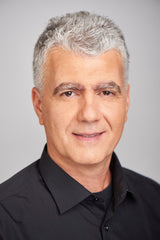
Founder & CTO of VAXA Technologies, Professor Isaac Berzin was named one the 100 most influential people by Time Magazine for his work in sustainability and climate change, Isaac is an Affiliated Scientist at MIT, where he worked on a NASA sponsored project, developing bioreactors for the International Space Station. His innovative work in GreenFuel Technologies has won numerous awards including the Frost and Sullivan Award (2006), Platts Global Energy Award (2006) and American Society of Competitiveness (ASC) Awards 2005, 2006, 2007. Isaac holds a PhD in Chemical Engineering and Biotechnology from Ben-Gurion University of Negev, Israel.
